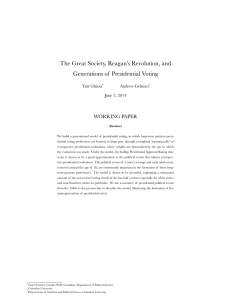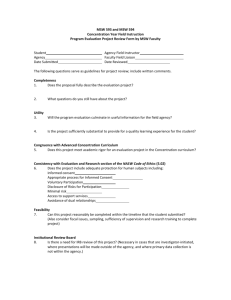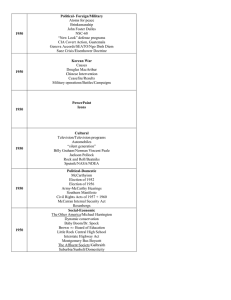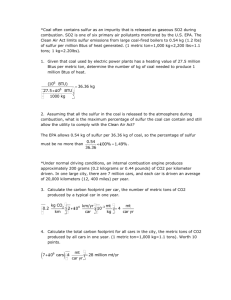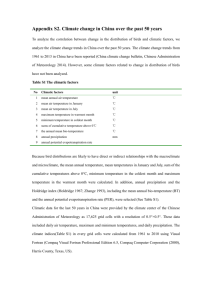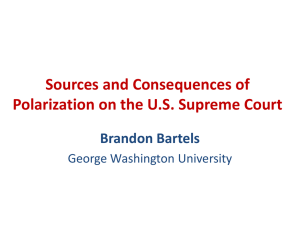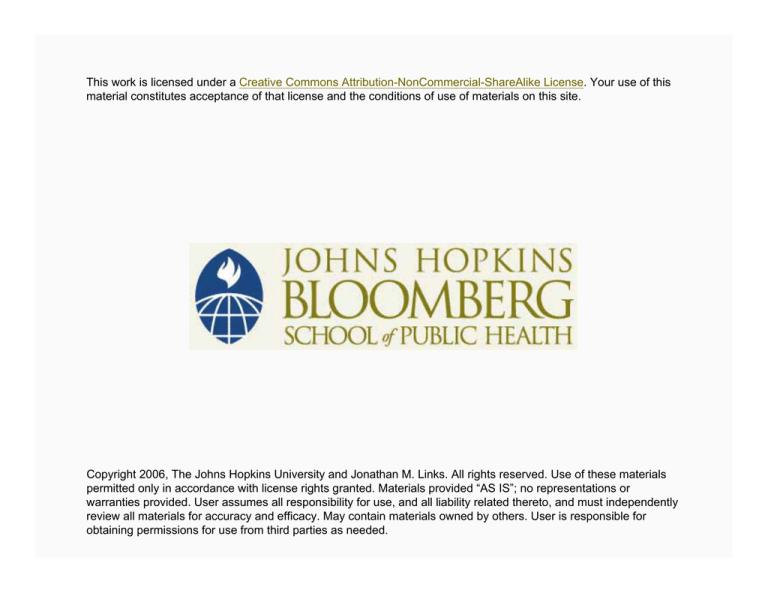
This work is licensed under a Creative Commons Attribution-NonCommercial-ShareAlike License. Your use of this
material constitutes acceptance of that license and the conditions of use of materials on this site.
Copyright 2006, The Johns Hopkins University and Jonathan M. Links. All rights reserved. Use of these materials
permitted only in accordance with license rights granted. Materials provided “AS IS”; no representations or
warranties provided. User assumes all responsibility for use, and all liability related thereto, and must independently
review all materials for accuracy and efficacy. May contain materials owned by others. User is responsible for
obtaining permissions for use from third parties as needed.
How Humans Impact the Environment
Jonathan M. Links, PhD
Johns Hopkins University
Environmental Sciences
The natural environment
− Ecology
Man’s impact on the natural environment
− Ecology and environmental engineering
The environment’s impact on man
− Environmental health sciences
3
The “Environment” and Health
The natural environment
The built environment
The social environment
4
Human/Environment Impact Circle
Humans
Environment
Precepts
The physical environment, our habitat, is the most important
determinant of human health
Protection of the environment and preservation of
ecosystems are the most fundamental steps in preventing
human illness
Environmental problems are global and long-term
Human belief systems are part of the problem
6
The Earth as a Fishbowl
Ecosystem
Solar
energy
Natural Resources
Energy Resources
Environmental Services
Heat
7
Small Population and Little Technology
Small population and little technology—society has low
impact on environment
ENVIRONMENT
Deplete
Pollute
SOCIETY
Traditional
economics
8
Our Expanding Numbers
10
World population growth throughout history and near-term future
9
8
2.5 M
yrs ago
7000
B.C.
4000
B.C.
6 billion—1998
6
5 billion—1987
5
4 billion—1974
4
3 billion—1959
3
2 billion—1938
2
1 billion—1830
1
1000
B.C.
A.D. A.D.
1 2040
Billions of People
7
9
Larger Population and Increased Technology
Larger population and increased technology—society has
great impact on environment
ENVIRONMENT
Deplete
SOCIETY
Pollute
Environmental economics
10
Societal Needs and Wants
N
E
E
D
S
W
A
N
T
S
W
A
N
T
S
ENVIRONMENT
11
Why Do We Pollute the Environment?
Driving forces
—Population
—Technology
—Economic, political,
and social values
Human
behavior
—Needs
—Wants Mitigating forces
—Environmental laws
—Market adjustments
—Informal social
regulation
Environmental
change
12
The Industrial Process and the Environment
Chemical inputs
(raw materials)
Power inputs
(gas, oil coal)
Other inputs
(water)
I
N
D
U
S
T
R
Y
Air
pollution
Water
pollution
Toxic
waste
The product
itself
13
Environmental Impact (A Model)
I=PxAxT
I = environmental impact; P = population;
A = affluence; T = technology
Growth in
environ. impact
=
Growth in
population
x
Growth in
affluence
x
Growth in
technology
Consumption
14
U.S. Material Consumption Trends
Million Metric Tons
800
Indust. Minerals
Metals
Nonfuel Organics
Paper
Wood
Agriculture
600
400
200
0
1910
1930
1950
1970
1990
15
U.S. Household Ownership of Appliances
100
Percent
80
60
40
20
0
1960
Color TV
1970
Air Conditioners
1980
Microwave
1990
2000
Video Recorders
16
Million Tons of Oil Equivalent
World Fossil Fuel Use
9000
7500
6000
4500
3000
1500
0
1950
1960
1970
1980
1990
2000
17
Sulfur and Nitrogen Emissions from Fossil Fuel Burning
Worldwide emissions from burning fossil fuels
Million Tons
80
60
40
20
0
1950
1960
1970
Sulfur
1980
1990
2000
Nitrogen Dioxide
18
The London “Killer” Smog of 1952
Daily concentrations of smoke and sulfur dioxide are related
to the number of “excess” deaths each day in London
Adapted by CTLT from….
19
World Automobile Production and Fleet
600
30
400
20
200
Fleet (millions)
Production (millions)
40
10
0
0
1950
1960
1970
Production
1980
1990
2000
Fleet
20
MSW and Per Capita Generation of MSW
Municipal solid waste (MSW) and per capita generation of
MSW
200
180
160
140
120
100
80
60
40
20
0
5
4.5
4
3.5
3
2.5
2
1.5
1
0.5
0
1960
1970
1980
Million Tons of MSW
1990
Pounds/Person/Day
Million Tons
2000
Pounds/Person/Day
21
The Big Questions
1.
2.
What is this pollution doing to us?
What can we do about it?
22
Problem-Solving Paradigm: Six Steps
1.
2.
3.
4.
5.
6.
Define the problem
Measure its magnitude
Understand key determinants
Develop intervention/
prevention strategies
Set policy/priorities
Implement and evaluate
Risk assessment
Risk management
23
Risk Assessment and Management
Hazard
identification
Exposure
assessment
Doseresponse
assessment
Risk characterization
Risk
communication
Risk management
24
Dose-Response Curve
100%
R
e
s
p
o
n
s
e
Carcinogens
Non-carcinogens
0
Dose
25
Dose-Response Curve
Observable
Range
R
e
s
p
o
n
s
e
Range of Inference
Dose
26
Risk Management Approaches
Engineering
− Process controls
− Emission reduction
Social and behavioral
− Worker training
− Risk communication and risk reduction
27
Risk Management Approaches
Regulatory
− Emission limits
− Mandated processes
28
Perceived vs. Actual Risk
Underprotection
Optimum
Protection
Public
Policy
Public
Policy
Public
Policy
Perceived
Risk
Perceived
Risk
Perceived
Risk
Overprotection
Actual
Risk
29
Recognition of a Broader Environmental Impact
Food security
Climate change
Deforestation
Desertification
Land degradation
Stratospheric ozone depletion
Loss of biodiversity
30

